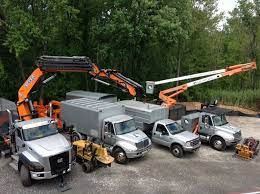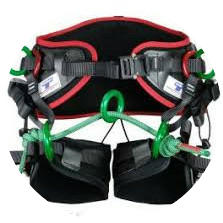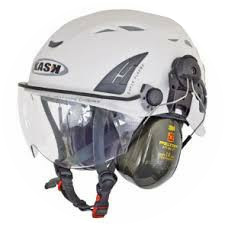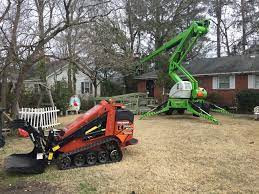
Over the years tree work equipment has taken leaps and bounds with what is now being used. Much of the products offered have gone through years of new-age technology to make for a safer, faster, more comfortable work experience. Many of the products are now lighter because the old equipment was made out of solid steel whereas most are made out of lightweight aluminum or even carbon fiber.
Tree climbing harness
One of the first pieces of equipment that I think about when doing any type of tree work is a nice lightweight durable harness with a lanyard so that you can stay tied in. Even if you are trimming an apple tree it’s best to climb your way up while staying tied in the entire time. The mechanism that I use while climbing is an 11 to 12 mm climbing line or lanyard with a spliced end. Then I use a french prusik with a pulley through the rope then a carabiner to advance the knot upward with one hand so you can always keep the other hand or arm grasping the tree.
The harness I like the best is the Teufelberger-Tree motion harness because it is comfortable plus versatile with two sets of D rings. One set is on both sides of the hips like all harnesses while the other set is on each thigh so you can use the climbing line as a lanyard on one set and the regular lanyard on the other. Using both sets of D rings like this allows you to stay tied in one hundred percent of the time while advancing around limbs, branches, or the trunk where you need to untie one or the other to advance up the tree from time to time.
Tree Climbing rope
When it comes to tree climbing ropes there are many to choose from. I like the Pelican rope tree viper with a pre-spliced eye at both ends with u shaped carabiners with the three-point opening system. The three-point opening system is basically foolproof as long as you know your stuff and stay on your toes!
Other great ropes that I have used in the past are Lava or Poison ivy both come in multiple colors so you can choose the one that suits you best.
There are also rigging ropes that are usually braided or three-strand which makes them stronger. These ropes are used to assist workers when taking down a tree that is over objects like a house or garage. Anywhere that something or someone can get damaged or injured is a candidate for rigging and roping.
It is also wise to store your ropes in rope bags so they don’t get damaged.
Tree climbing spikes
Tree climbing spikes are only to be used on trees that are going to be removed because they puncture the tree’s vascular system which will wound the tree. Spikes can also kill the tree by creating open wounds which can then be susceptible to a parasite, bacterium, or infection. The spikes I recommend are the Notch gecko 2.0 that are aluminum so they are lightweight but still extremely strong so they last a long time.
Personal protective equipment or PPE
When doing any type of tree work it is imperative that the worker uses all the essential PPE. The first that I recommend is a helmet that now comes with built-in visors, face screens plus they come with built-in ear muffs. The helmets I like the best are the Pfanner, Kask, or Petzl helmets that are ventilated to allow air to cool your melon while you are working up a sweat.
The next piece of PPE that is essential is shatterproof safety glasses so that your eyes are protected from any ricocheting debris that is if your hard hat does not incorporate a visor already.
Then there is protecting clothing that is sometimes double or triple stitched like arbor wear who makes pants, shirts, sweatshirts, jackets, and hats. Arborwear is all well-made high-quality clothing that will last a long time. On the topic of protective clothing is chaps to protect your legs from a chain saw cut. Chaps are made with a special material that binds up the chain to make it stop spinning immediately. Some arborist clothing companies make pants with build-in chainsaw-proof material. Other protective clothing is a pair of high-quality work boots with steel toes, yet Vibram soles to protect your feet while keeping you free from an ankle sprain.
Tree working trucks (otherwise known as bucket or boom trucks)
There are many different manufacturers of boom trucks. To list a few are Ford, Dodge, Chevy, International, Freightliner. and Mercedes Benz. These trucks are specially made with a central rotating Rotex pedestal gear that is positioned onto the truck’s frame in the center of the vehicle. Many traders use bucket trucks, from telecommunications to construction, to forestry, to power companies.
From the pedestal, it has a lower arm and an upper arm that both fold out to extend to the desired working height. The upper arm also contains a basket or bucket that the worker rides in to lift him to where he needs to be. These trucks also rotate at 360 degrees and most fold over-center meaning that once you get vertical the lower boom goes an additional 25 degrees. This over-rotation is very convenient and useful. These trucks usually come in 40,50,60,70, 80, and 100 footers. For the trucks that go higher than 50 to 60 ft they usually have a hydraulic telescoping feature that extends out of the central Rotex pedestal to get an extra 10 to 15 ft of working height.
To support the booms and workers, while in the air, these trucks come with outriggers which are hydraulic 45-degree steel legs that come down at an angle to stabilize the truck from tipping. To set them you just push the lever down until the sag in the tire decreases. Some trucks come with 2 outriggers while some come with 4. If they are only two the support legs are in the center of the vehicle. If they come with 4 they are in the middle and back of the truck.
Aside from the lift, bucket trucks also come with a hydraulic dumping chip box on the back that is used for collecting tree materials such as wood and chips. These trucks are also designed to tow a chipper so you can tackle many aspects of tree work with a single truck towing a chipper. The driver or owner of the bucket truck can also tow a trailer with a skid steer or excavator as well if need be.
One thing about bucket trucks that I want to mention is that most are over 28,000 lbs which means that you are required to obtain a CDL (commercial driver’s license) in order to drive the truck. Many trucks also have airbrakes so an airbrake endorsement is mandatory as well. Some boom trucks are under the 28,000 lb weight so the driver is not required to carry a CDL.
Tree work chippers vs apprentice loaders vs skid steer and dump trailer vs dingos with a grapple 
Chippers are a much-needed machine when doing tree work. They grind up the brush and branches into small particles that then get made into mulch that we all use in our gardens or around our landscape. The manufacturers of chippers are Morebark, Vermeer, Brushbandit, and Altec.
If the arborists don’t have a chipper you can also stage the brush or tree trunks on the side of the road and then come pick it up with an apprentice loader later. This truck is like a boom truck but instead of the bucket, it has hydraulic clampers that are shaped like a C that close, for picking things up.
If the workers don’t have a chipper or apprentice loader they can use a dump trailer with a skid steer that has a grapple attachment for picking up the debris.
Many arborists are now using dingos that are either Bobcat, Toro, Vermeer or Kubota. With these machines, you can stand on a platform on the back while riding around picking up material with a grapple then placing it in a dump trailer.
Conclusion
Along with tree work comes a lot of equipment ranging from safety equipment that a person wears to large machinery that people operate to get the work done. Trees are important to us all, yet they are everywhere so tree work is something that we will always have to do. My objective was that you enjoyed this article if you have any thoughts or comments please leave one or send me an email.

